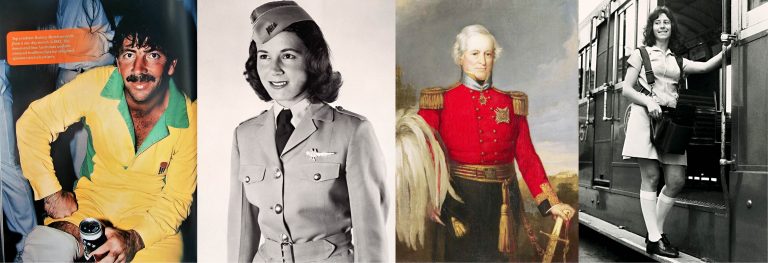THE HISTORY OF AUSTRALIA’S UNIFORMS IS A VIVID SPECTACLE OF COLOUR AND CULTURE
JOHN McNAMEE REPORTS
From the gorgeous gold-braided scarlet tunics of the early colonial military commanders…to the hideous “magpie suits” worn by the worst-offending convicts….
From the elegant tailored jackets and stylised wings badges of the early airline stewardess….to the controversial yellow “mini-skirts’ of the tram conductresses in the 1970s….
From the stern, functional, dark police uniforms and formal caps of the early colonial days ….from Captain James Cook’s sedate naval uniform… to larrikin wicket-keeper Rodney Marsh, resplendent in his sweaty, vividly coloured “pyjama suit” relaxing with a tinnie after a hard-fought one-dayer…
These are just some of the images which chronicle the creation and development of Australia’s reliance on the uniform which became an iconic part of our history.
And there’s dozens more similar photographs, etchings, sketches, paintings etc outlined in the pages of a fascinatingly unusual book, Badge, Book, Button: The Story of Australian Uniforms.
The extremely colourful and well-documented work, which has taken its Sydney author Craig Wilcox more than two years to complete, has just been released.
Craig, 57, an historian attached to the National Library of Australia and formerly with the Australian War Museum, admits he’s had a fascination with uniforms since his childhood.
“One of my earliest memories of the home where I grew up is the photograph of my grandfather in army uniform, it obviously had a strong effect on my early life,” Craig told Go55s.
“Abd before I took up history as a career I went to art college and was a member of several brass bands and so I was always involved with uniforms in one way or another,” he said.
Of all the images in the book which chronicles the history of uniforms worn in Australia from 1788 to the present day, I ask Craig which is his favourite.
“Well I’d have to say the magnificent portrait of Sir Maurice O’Connell, a popular military commandant of 19th century NSW.
“It was probably painted after his death from existing sketches. Apart from the majesty of the portrait, I like it also because although he was a typical British military figure, he immersed himself and his family in our early colonial society and contributed a lot to improving the social conditions.
“Another reason I like it is because Sir Maurice is buried in a fairly simple gravesite at Newtown cemetery which is near where I live in Erskineville,” Craig says.
As well as the pomp and glamour of the high-ranking colonial civilian and military leaders, there are also significant portraits of some of the Indigenous sportsmen and tribal elders such as Aboriginal cricket player Nannultera depicted in an early painting wearing a bright red shirt and wielding a cricket bat used in the late 1850s.
Another major work is Augustus Earle’s portrait of Kuringgai man, Bungaree, wearing the British army “redcoat” and for his loyalty to the colonists he was awarded the title “king”.
In his introduction to the book, Craig writes: “Uniforms conceal and uniforms reveal…they envelop us in costumes akin to flags, in the bold designs and memorable colours of official, corporate and communal hierarchies…
“And like any language they reveal origins, status, aspirations and insecurities…”
It is outlined in the book that the Australian military followed Britain’s example in regards to uniforms, fitting soldiers out in the traditional redcoats.
These garments of course were impractical in the colony’s scorching heat and were widely mocked.
“Eventually the local militias decided that they didn’t want the redcoats because they didn’t want people to think of them as British army… they wanted to have an identity of their own,” Craig explains.
“Gradually they began to adopt a more bush style garb similar to what was later to become the standard khaki of the early 20th century AIF.
“It was also at that time that the wide-brimmed felt bush hat developed and one of the sides was slouched or bent. It was actually worn in many other countries including Africa and Asia but the assumption they were distinctly Australian led to them being adopted as part of the uniform,” he said.
The book explains that the slouch hat had a mixed reception in the mother country when an Australian officer in London was jokingly addressed as “Buffalo Bill”.
However, the British top brass accepted the slouch hat and it was worn by the Australian mounted brigades in the Boer War.
“The slouch hat was actually designed for horse-mounted troops and it may or may not have been also a practical headwear for troops carrying long rifles or muskets etc,” Craig says.
But the uniform phenomenon was not only restricted to the military and civil forces..over the past few decades airlines have tried to outdo each other in arraying their female cabin staff in all sorts of high fashion uniforms.
And sports people also forged their own heritages in uniforms and playing gear.
As the book explains: “The nation was scandalised as swimsuits worn by athletes and lifesavers gradually became shorter…one early Olympic track and field athlete shortened her own full-length track uniform with scissors after realising her non-Australian opponents, in shorts, were far better adapted to track events.
“There was greater shock when women’s hemlines lifted and this was reflected in uniforms, from that worn by air hostesses to the clothes of tram conductors.”
Still on sports people, there’s a beautiful photograph of Daphne Akhurst, in full flight on a tennis court, who like other female players of the 1920s, shed her dowdy bonnet and long sleeves and hitched up the skirt hemlines and raised the blood pressure of male spectators.
“I think another major factor for me was the transition for example of the police uniforms…in the early part of the 20th century of course they were pretty straight military-style but not as severe.
“You got the impression that they were the upholders of the law but they were also part of our local society and they exuded an aura of authority and understanding.
“Nowadays, the police uniform is more confrontational, with the baggy trousers tucked into the combat-style books, the heavy weaponry, bullet-proof vests… it’s almost a commando style…it says “we’re ready to crack down on any violence and we’re not mucking around”.
“Sadly, it’s a reflection of our times I suppose,” Craig says.
Other fascinating sections of the book deal with the evolution of the Aussie footy jersey from its working class roots to the more practical cut down versions of later years.
Despite its heavy reliance on the history of the mainly military and civilian services, the book really does dramatically illustrate the wonderful spirit of ordinary Australians whose lives were fashioned by the wearing of a particular uniform.

Badge, Book, Button: The Story of Australian Uniforms, by Craig Wilcox is published by The National Library of Australia. RRP $44.99
Photo 1 – Rodney Marsh in his brightly-coloured ‘pyjamas’ celebrates with a tinnie after a cricket one-day game
Photo 2 – This stewardess from the 1950s models the outfit for the MacRobertson Miller Airlines of WA
Photo 3 – British officer Sir Maurice O’Connell in the splendid uniform of military commandant of NSW
Photo 4 – In the 1970s female tram conductors adopted the sassy yellow ‘mini-skirt’ and white sox to match the colour of the Melbourne Trams




